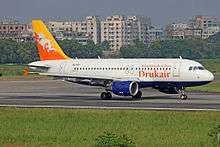Druk Air
Drukair Corporation Limited (Dzongkha: འབྲུག་མཁའ་འགྲུལ་ལས་འཛིན།), operating as Drukair — Royal Bhutan Airlines, is the flag carrier of the Kingdom of Bhutan,[4] headquartered in the western dzongkhag of Paro.[5]
 | |||||||
| |||||||
| Founded | 5 April 1981 | ||||||
|---|---|---|---|---|---|---|---|
| Commenced operations | 11 February 1983 | ||||||
| Operating bases | Paro Airport | ||||||
| Frequent-flyer program | My Happiness Reward | ||||||
| Fleet size | 5 | ||||||
| Destinations | 15 | ||||||
| Headquarters | Paro, Bhutan | ||||||
| Key people | Tandi Wangchuk (CEO)[2] | ||||||
| Revenue | |||||||
| Website | www | ||||||
Founded in 1981, ten years after Druk Gyalpo Jigme Dorji Wangchuck gradually began to open up the kingdom from self-imposed isolation, and seven years after welcoming its first foreign visitors, the airline commenced operations in 1983 with flights from Kolkata to Paro utilising Dornier Do 228 aircraft. A switch to BAe 146-100 equipment occurred in November 1988, and in order to meet increased demand, those aircraft were replaced in 2004 with two Airbus A319s.
Drukair operates a modest scheduled flight network within the South Asian and Southeast Asian region from its base at Paro Airport and currently serves twelve destinations in six countries.[6]
History
In 1968, the Indian Border Roads Organisation built an airstrip in the Paro valley, which was initially utilised for on call helicopter operations by the Indian Armed Forces for the Royal Government of Bhutan. After consideration by King Jigme Singye Wangchuck and the Tshogdu, Drukair was established by Royal Charter on 5 April 1981, ten years after the Druk Gyalpo, King Jigme Dorji Wangchuck gradually began to open up the Kingdom from self-imposed isolation, and seven years after welcoming its first foreign visitors.[7][8][9]
Paro Airport is located deep in a valley 2,235 metres (7,333 ft) above sea level, and is surrounded by mountains as high as 4,900 metres (16,100 ft).[10] At the time, the runway was 1,200 metres (3,900 ft) in length,[7] giving the Bhutanese government specific requirements for a choice of aircraft to be operated. They required an 18–20 seat STOL-capable aircraft with operating capabilities which included a high service ceiling, high rate of climb and high manoeuvrability. The major requirement for the aircraft was that it must be capable of flying Kolkata – Paro – Kolkata, a 1,200 kilometres (750 mi) round-trip flight, without refuelling, due to minimal infrastructure being available at Paro for this purpose. Three different aircraft types were considered after flight tests in India and Bhutan between 1978 and 1980; however, none was deemed suitable.[7]
In mid-1981, the Indian government set up a committee to study its own requirements for a light transport aircraft. Based upon this competition, the Bhutanese government ordered one Dornier 228-200 for delivery in January 1983, with the option for a second aircraft for delivery in late 1983. The first 18-seat Dornier 228-200 landed at Paro Airport on 14 January 1983, the exact time of landing, the number of passengers on board and even the direction the aircraft was parked on the airport apron being predetermined by the high lama of Paro Dzong.[7]
The airline inaugurated scheduled revenue flights on 11 February 1983, with Flight 101 departing Paro for Kolkata and returning the next day as Flight 102. For the first four weeks the flight was operated three times a week, after which it was increased to a daily flight.[7] At the time of service commencement, Paro Airport consisted of the runway, a two-room air traffic control building (with the ground floor acting as the check-in counter) and a departure lounge on the lawn.[11] Prior to the establishment of the Department of Civil Aviation in January 1986, the airline was responsible for the operation and maintenance of airport infrastructure.[12] The airline commenced flights to Dhaka in Bangladesh on 30 October 1986.[13][14]
| 1983 | 1984 | 1985 | 1986 | 1987 | |
|---|---|---|---|---|---|
| Passengers flown | 2,854 | 4,480 | 5,928 | 7,776 | 8,700 |
| Distance flown ('000 km) | 64 | 125 | 125 | 205 | n/a |
| Revenue passenger kilometres ('000 km) | 1,612 | 2,531 | 3,349 | 4,381 | n/a |
Jet era
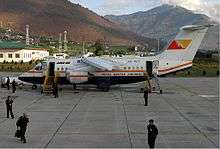
On 30 December 1987, a US$25 million order was placed with British Aerospace for a BAe 146-100 STOL regional jet.[16][17] The purchase of the aircraft was financed by the government, obtaining, for the first time in the country's history, a commercial loan.[18] In 1988, the airlines' operational base was shifted from Kolkata to Paro Airport and the airline also hired its first seven flight attendants who were trained by Thai Airways International.[13] On 21 November 1988, the BAe 146 was delivered to Paro Airport. With the introduction of the BAe 146, Drukair was able to widen its network to link Paro with Delhi on 26 November 1988, Bangkok on 28 January 1989 and Kathmandu in April 1989.[14] In the first full year of operational service with the BAe 146, the airline achieved an average load factor of 50–60 percent, more than the 40 percent which was expected, carrying 12,732 passengers over the 1989 – 1990 period.[14][19] In 1990, the runway at Paro Airport was lengthened from 1,400 metres (4,600 ft) to 2,000 metres (6,600 ft) and reinforced for heavier aircraft.[13][20] A hangar was also constructed for the aircraft, which was funded by the Indian government as part of the Paro Airport Development Project.[8]
The airlines' only aircraft was requisitioned by King Jigme Singye on 9 November 1990, in order to allow the king and his party to travel to Tokyo for the coronation of Akihito as Emperor of Japan.[21] From Japan, the King then travelled to Malé in the Maldives for the South Asian Association for Regional Cooperation summit between 21–23 November, and returned to Bhutan in order for the aircraft to re-enter service with the airline on 25 November.[21] Due to a requirement stipulated by the Bhutanese government that all foreign tourists, with the exception of Indian nationals, enter and leave Bhutan by air, the country's tourism industry was brought to a halt, which saw the airline paying hefty penalties to disgruntled tour operators.[9][21] This problem was somewhat alleviated when a second BAe 146 entered service in 1992,[22] and on 11 November 1993, the airline introduced a 10 Executive Class on the aircraft.[13] On 13 May 1991, Drukair was registered under the Companies Act of Bhutan.[13] Service to Yangon, the capital of Myanmar, began on 6 January 1997.[23]
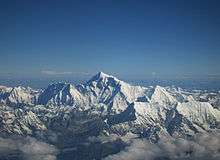
During 2000–2001, Drukair could operate with only one single aircraft for over a year due to a corrosion defect in its A5-RGD aircraft in the wing tanks that was detected during a check at Woodford. The wings were replaced. In 2002, an RJ70 was wet-leased from airBaltic to cover for maintenance to A5-RGE.[25]
Drukair became the launch customer for the Avro RJX-85 in April 2000 when it placed an order with BAE Systems for two aircraft, with deliveries initially scheduled to take place in November 2001 and January 2002.[26] Delays in the first flight and certification of the RJX pushed back expected delivery to Drukair to after April 2002.[27] BAe Systems cancelled the RJX program in November 2002,[28] due to receiving orders from only two airlines,[29] Drukair and British European.[28] With British European threatening legal action to enforce their contract with BAE Systems,[30] the aircraft manufacturer offered to fulfil the contract for Drukair, although airline management decided against acquiring the aircraft, citing potential problems with sourcing spare parts for the aircraft in future.[29]
In order to find a replacement for the 2 BAe 146s, Drukair management fielded submissions from Airbus, Boeing and Embraer to determine their products' suitability to meet Drukair's stringent operational requirements. Bombardier was also invited by management to demonstrate the CRJ900 regional jet,[31] however, the airline was advised by Bombardier the aircraft would be unsuited for operations at Paro.[32] In February 2002, the Airbus A319 became the largest aircraft to ever land at Paro Airport, when Airbus demonstrated the aircraft to the airline. By October, Boeing had withdrawn from the competition due to not being able to source an aircraft to demonstrate to the airline. With the Embraer E-190 yet to fly, it was expected that Drukair would order the A319. However, the government had concerns regarding financing for the purchase, and in October the final decision was delayed.[33] After a short period of time, the government instructed management to begin evaluations once again,[32] and a Boeing 737-700 conducted eleven test flights at Paro Airport in February 2003, in which it was demonstrated it met the requirements of the airline for operation into Paro.[34]
Airbus signed a memorandum of understanding with Drukair in July 2003 for two 114-seat Airbus A319-115, powered by two CFM56-5B engines, for delivery in the second half of 2004.[35][36][37] The purchase of the two jets, valued at 3,534.36 million Bhutanese ngultrum (BTN),[16] was the biggest single purchase ever made by Bhutan, and was largely responsible for a 250 percent increase in the Bhutanese trade deficit over the previous year for the financial year 2004–2005.[38][39] The Bhutanese government issued BTN 1,767.18 million in government bonds to pay for one aircraft and for only the second time in Bhutan's history intended to seek a commercial loan for the other aircraft.[16][18] However, in October 2004 it announced it would instead seek a soft loan for this purpose.[16]
On 11 November 2003, the king's birthday, Drukair initiated services to Gaya, India.[40] Bodh Gaya, 10 kilometres (6 mi) from Gaya, is the site of the Mahabodhi Temple where Siddhārtha Gautama, the Buddha, reached enlightenment, and 30,000–40,000 Bhutanese make the pilgrimage every year.[41] Pilgrims have previously made the pilgrimage to Bodh Gaya via a 2–3-day overland trip from the Bhutanese border town of Phuntsholing, and Drukair management plans on acquiring 20–30% of this traffic,[40][41] although the airline had yet to record a profit on the route at of February 2006.[42] The following month, as a result of Royal Bhutan Army efforts to expel from Bhutan territory Indian separatist insurgent groups, notably the United Liberation Front of Asom and the National Democratic Front of Bodoland,[43] flights to Dhaka were suspended from 29 December in order to prevent insurgents from using Drukair flights to escape to alleged hideouts in Bangladesh.[44][45]
Airbus era
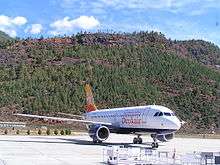
The first Airbus A319 arrived in Bhutan on 19 October 2004;[35] the date chosen after a Buddhist astrologer was consulted to ensure the aircraft arrived in Bhutan on an auspicious day in the Buddhist calendar.[16] Before entering service on commercial flights on 31 October 2004,[46] Drukair took their A319 on a country-wide flight in honour of the ascension of Crown Prince Jigme Khesar Namgyel Wangchuck to the Chhoetse Penlop.[16] The second aircraft was delivered by Airbus to Drukair in December 2004.[47] On 31 August 2012, Druk Air took delivery of a third Airbus A319.[48]
In July 2005, the governments of India and Bhutan signed a new bilateral air services agreement which increased the allowable number of weekly flights between the two countries from 12 to 49. In addition to destinations already served by Drukair, the cities of Mumbai, Chennai and Guwahati were included in their services agreement, with Bhutan being granted fifth freedom rights from several Indian cities to onward destinations such as Yangon, Dhaka and Singapore.[49][50]
Domestic helicopter service was inaugurated in November 2005,[51] in line with a resolution by the Council of Ministers in April 2001 which stated that domestic services should be introduced. Thirty heliports across the country were identified, and the introduction of services saw, for example, the 550 kilometres (340 mi) trip from Thimphu to Trashigang taking only one hour, instead of two to three days.[52] The Eurocopter Ecureuil helicopter operated by the Nepalese operator, Air Dynasty, had by January 2006 seen 30 hours of service, netting Drukair US$3,000 in profits.[51]
Flights to Dhaka, suspended since 29 December 2003, resumed on 23 October 2006,[53] and the airline was given rights to fly to Chittagong and Cox's Bazar by the Bangladeshi authorities.[54] The airline announced plans in July 2007 to start scheduled flights to Mumbai via Kathmandu from March 2008,[55] inline with the strategy of Drukair management to increase the number of Indian tourists travelling to Bhutan during the low season months of June through August and November through February.[56] These plans were put on hold in March 2008, due to Paro Airport not being able to handle night flights and the airline only being able to secure landing slots at Mumbai's Chhatrapati Shivaji International Airport at 3 am.[56] Plans for services to Hong Kong, Singapore, Abu Dhabi, Dubai and Sharjah were also shelved.[56]
The airline posted its first profit in 2007 of BTN 31.15 million.[57] The two BAe 146 aircraft were sold to Star Perú in October 2007 for US$3.3 million, and left Bhutan for Peru in November and December 2007.[58][59]
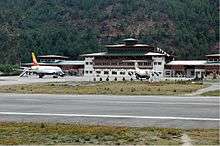
Druk Gyalpo Jigme Khesar Namgyel Wangchuck on 11 November 2007 issued a Royal Kasho establishing Druk Holding and Investments Limited, a holding company which would manage existing and future investments of the Royal Bhutanese government. As a result, seven government-owned companies, including Drukair, had their ownership transferred from the Ministry of Finance to the newly formed holding company.[60] Incorporated on 13 November 2007, Druk Holding and Investments announced in December 2007 that given Bhutan's tourism industry being reliant on Drukair, the head of the government agency overseeing tourism development in Bhutan would become the chairperson of Drukair, and would be responsible for improving the performance of the national airline.[61]
In March 2008, Drukair introduced a new uniform for its flight attendants, consisting of a contemporary kira and tego.[62] The uniforms were introduced for the centenary celebrations of the monarchy, as well as the airlines own silver jubilee.[22] The uniform was chosen by way of a competition in which five Bhutanese fashion designers submitted entries, with the winner receiving a BTN 75,000 prize.[62] The textiles used in the new uniform were chosen via a competition which was jointly organised by Drukair and the United Nations Development Programme to promote the Bhutanese textile industry and culture.[63][64]
Although the government of Bhutan goes to great lengths to prevent outside influences from intruding on Bhutanese culture, Drukair is not immune to problems which affect the airline industry and the world community at large. In June 2008, citing hikes in the price of oil and the need to contain operational costs, the airline reduced frequencies across its network and announced an increase in airfares to offset the increased costs, whilst taking advantage of the lower cost of jet fuel at Delhi, Kolkata and Bangkok airports.[65] Due to its small network which is reliant on fifth-freedom rights,[66] Drukair regularly leases its aircraft to other airlines, such as Myanmar Airways International and Bangkok Airways in order to keep utilisation rates on its aircraft higher than they would under normal circumstances, whilst at the same time earning extra revenue.[66][67][68][69]
The airline was due to begin flights on 20 April 2009 to Bagdogra Airport in India, but had to delay the inaugural flight due to the lack of immigration and customs facilities at the airport.[70] The inaugural flight to Bagdogra Airport left Paro Airport on 18 June 2009, making Drukair the first international airline to operate into the airport. In Bagdogra, a ceremony was held which was attended by S. M. Krishna, the Indian Minister for External Affairs, and Lyonpo Ugyen Tshering, the Bhutanese Minister of Foreign Affairs.[71]
Contemporary developments
Until 23 August 2010 Drukair was the only airline flying into Bhutan.[72]
The airline is an important for the Bhutanese people,[66] connecting Bhutan with the outside world and supporting tourism and export markets.[73][74][75]
In October 2009, the Bhutanese government planned construction works of an airstrip in Yongphulla. The airstrip, which was expected to be 3,900 feet (1,200 m) in length and operational by March 2010, would allow for service by small aircraft in the 15–16 seat category.[76] The project was being financed with Nu. 34 million from the budget which was previously allocated to the development of domestic helicopter services. The airstrip would only be operational during the morning hours due to high winds in the afternoon, making safe operations risky.[77]
Drukair is conducting a feasibility study into operating flights to the airstrip from Paro, as well as, two others which are under construction at Bathpalathang and Gelephu.[78][79]
In 2006 the Indian government acting for the Bhutanese government, conducted a feasibility study into the viability of an international airport near the southern Bhutanese town of Gelephu.[49] In the five-year plan (which covers 2008–2013) the sum of BTN 2,826 million had been allocated by the Bhutanese government for development of the new airport.[80] A preliminary survey was conducted by India in May 2006 and the survey team from the Airports Authority of India was to return and complete the final survey in September 2006. In October 2008 the project was shelved, and the Bhutanese government decided that the airport at Gelephu would be used for domestic flights only.[81]
Since then, the construction of a domestic airport at Gelephu has been scheduled to commence in late 2010 with the airport proposing to start operations in June 2011. The Bhutanese Department of Civil Aviation (DCA) has indicated that Gelephu's will be an 'all-weather' airport that may be able to accept some international traffic in the future.[81]
Under the Vision 2020 Plan, the Royal Bhutanese Government has identified the requirement for improved external air links by 2017, in an effort to increase tourism revenue 100% by 2012 and 150% by 2017.[82] Drukair is conducting feasibility studies into the commencement of operations to either Hong Kong or Singapore by March 2011. The airline's commercial manager has stated that preliminary studies show that Bhutanese traffic to Singapore would consist mainly of official travel, whilst traffic to Hong Kong would be mainly commercial, with good prospects for tourism development.[83]
On 21 April 2010, an ATR 42 turboprop regional aircraft was delivered to Paro under a nine-month lease. The aircraft was used on flights from Paro to Kolkata and Kathmandu, and was on standby during the South Asian Association for Regional Cooperation summit in Thimphu at the end of April.[83] Drukair announced its intention to join the International Air Transport Association in 2009.[84]
During February 2018, Druk air performed a few charter flights to Hong Kong and additional charter flights were on slate during the following months. The airline had received request for charter flights to other destinations in Asia . It was also reported that Druk air would be adding an Airbus 320NEO aircraft as well as purchasing a new ATR-42-600 aircraft.[85]
Drukair took delivery of its new ATR 42-600 on 22 October.[86]
Destinations
Drukair operates scheduled flights to the following destinations:[87][88][89]
Fleet
As of October 2019, the Drukair fleet consists of the following aircraft:[93]
| Aircraft | In Service | Orders | Passengers | Notes | ||
|---|---|---|---|---|---|---|
| J | Y | Total
| ||||
| Airbus A319-100 | 3 | — | 16 | 102 | 118 | |
| Airbus A320neo | 1 | — | 20 | 120 | 140 | |
| ATR 42-600 | 1[94] | — | 8 | 32 | 40 | |
| Total | 5 | — | ||||
An ATR 42-500 first operated on a nine-month lease from April 2010 was evaluated by the airline with the possibility of a future purchase. On 4 June 2011, a purchased ATR 42-500 arrived in Paro. Drukair had bought the 48-seater with the view of using it to service the domestic routes to Bumthang and Yonphula in late 2011.[83] On 22 October 2019, Drukair received a new ATR 42-600 following which it sold its ATR 42-500 to ATR.[95]
Services
Frequent flyer program
"My Happiness Reward" was launched by Drukair on 10 November 2014, in commemorating the birth anniversary of His Majesty the Fourth Druk Gyalpo Jigme Singye Wangchuck and in celebrating his enlightened and visionary philosophy of Gross National Happiness.[96]
The members of the program can accumulate miles corresponding to the distance flown on Drukair and the class of service availed. Accrued miles may then be redeemed for free air tickets (Happiness Reward Ticket), upgrades at airports (Happiness Class Upgrade) and other benefits. Drukair currently offers 3 tiers of membership: Silver (Basic tier), Gold and Platinum (the elite tier).
Accidents and incidents
- On 16 April 2016, Druk Air flight KB140 was damaged after flying through a hail storm while on approach to Guwahati. The aircraft, an Airbus A319-115, operated on a flight from Paro to Bangkok via Guwahati. While descending to Guwahati over the Garo Hills, hail stones damaged and punctured the nose cone of the aircraft. A safe landing was made at Guwahati. No Fatalities were reported.[97]
See also
References
- International Civil Aviation Organization (January 2008). "Designators for aircraft operating services, aeronautical authorities and services" (Edition No. 143). International Civil Aviation Organization: 1–38. Cite journal requires
|journal=(help) - "You ask, We answer". Bhutan Observer. 30 June 2008. Archived from the original on 14 June 2014. Retrieved 14 June 2014.
- BBS (English) – Drukair’s revenue decreases
- "Drukair Corporate Information". www.drukair.com.bt. Paro, Bhutan: Drukair Corporation Limited. 2018. Retrieved 21 April 2018.
- "Registered Office Archived 9 July 2011 at the Wayback Machine." Drukair. Retrieved on 3 July 2011. "Registered Office Drukair Corporation Ltd, Head Office, Royal Bhutan Airlines, Nemeyzampa,. Paro, Bhutan "
- "Drukair – Network (September 2016)". Archived from the original on 27 September 2016. Retrieved 26 September 2016.
- Christ, Rolf F. (June 1983). "Bhutan puts its flag on the world's air map". ICAO Journal. Montreal, Quebec, Canada: International Civil Aviation Organization. 38 (6): 11–13. Archived from the original on 17 December 2014. Retrieved 15 June 2014.
- Zimba, Dasho Yeshey (1996). "Three Decades of Planned Development". In Ramakant and Misra, Ramesh Chandra (ed.). Bhutan: Society and Polity (2nd ed.). Indus Publishing. pp. 177–178. ISBN 978-81-7387-044-6. Retrieved 14 June 2014.
- Mazurkewich, Karen (5 September 2001). "Bhutan Finally Opens Doors To Luxury Travel Sector". The Wall Street Journal. Retrieved 15 June 2014.
- "The A319 excels in operations from high-altitude airports" (Press release). Airbus. 8 February 2005. Archived from the original on 14 June 2014. Retrieved 15 June 2014.
- Chattopadhyay, Suhrid Sankar (9 May 2008). "Aiming high". Frontline. 25 (9): 122. ISSN 0970-1710. Archived from the original on 14 June 2014. Retrieved 15 June 2014.
- "Department of Civil Aviation". Ministry of Information and Communication (Bhutan). Archived from the original on 6 July 2011. Retrieved 25 April 2010.
- "On the Wings of a Dragon: 25 Years of Progress" (PDF). Tashi Delek. XIII (3): 76. July–September 2008. Retrieved 25 April 2010.
- Zimba, Dasho Yeshey (1996). "Bhutan Towards Modernization". In Ramakant and Misra, Ramesh Chandra (ed.). Bhutan: Society and Polity (2nd ed.). Indus Publishing. p. 144. ISBN 978-81-7387-044-6. Retrieved 30 July 2008.
- 6th Five Year Plan 1987 – 1992 (PDF). Thimphu, Bhutan: Gross National Happiness Commission. p. 79. Archived from the original (PDF) on 14 June 2014. Retrieved 15 June 2014.
- Kencho, Wangdi (5 October 2004). "Airbus 319 to arrive soon". Kuensel. Archived from the original on 10 June 2011. Retrieved 25 April 2010.
- "British Aerospace Orders". The New York Times. London. 31 December 1987. Archived from the original on 14 June 2014. Retrieved 25 April 2010.
- Wangdi, Kencho (24 January 2004). "Bhutan borrows more". Kuensel. Archived from the original on 10 June 2011. Retrieved 25 April 2010.
- Myerson, Allen R. (10 June 1990). "On the Wings of Drukair". The New York Times. Archived from the original on 3 April 2015. Retrieved 25 April 2010.
- Brunet, Sandra; Bauer, Johannes; De Lacy, Terry; Tshering, Karma (2001). "Tourism Development in Bhutan: Tensions between Tradition and Modernity". Journal of Sustainable Tourism. 9 (3): 243. CiteSeerX 10.1.1.120.6843. doi:10.1080/09669580108667401.
- "Waiting for Drukair". Himal. 3 (4): 22. November–December 1990. ISSN 1012-9804.
- "Drukair to celebrate silver jubilee" (PDF). Tashi Delek. XIII (1): 39. March 2008. Retrieved 25 April 2010.
- "Burma Press Summary" (PDF). New Light of Myanmar. 12 November 1996. Archived from the original (PDF) on 15 June 2014. Retrieved 15 June 2014.
- Brown, Lindsay; Mayhew, Bradley; Armington, Stan; Whitecross, Richard W. (2007). Bhutan. Lonely Planet. p. 26. ISBN 978-1-74059-529-2. Retrieved 15 June 2014.
- "About Drukair". Bhutan. Archived from the original on 4 February 2009. Retrieved 22 April 2010.
- "Drukair is launch customer for RJX". Air Transport World. 1 May 2000. Archived from the original on 3 April 2015. Retrieved 15 June 2014.
- Endres, Günter (8 May 2001). "Avro RJX makes first flight after subcontractor delays". London: Flight International. Archived from the original on 15 June 2014. Retrieved 15 June 2014.
- Fullbrook, David (11 December 2001). "Druk seeks RJX replacement". Singapore: Flight International. Archived from the original on 15 June 2014. Retrieved 15 June 2014.
- Coleman, Zach (12 December 2001). "Drukair's Upgrade Stalled". The Wall Street Journal. Retrieved 22 July 2008.
- "British European agrees to cancel RJXs". Flight International. 29 January 2002. Archived from the original on 15 June 2014. Retrieved 15 June 2014.
- "Bhutan's national carrier set to acquire two new aircraft". Airline Industry Information. 6 May 2002. Retrieved 15 June 2014.
- Ionides, Nicholas (25 March 2003). "Drukair revives suspended fleet renewal effort". Singapore: Flight International. Archived from the original on 15 June 2014. Retrieved 15 June 2014.
- "Boeing pulls out of Drukair fleet competition". Flight International. 8 October 2002. Archived from the original on 15 June 2014. Retrieved 15 June 2014.
- "737-700 Technical Demonstration Flights in Bhutan" (PDF). Aero. Seattle: Boeing Commercial Airplanes (23): 3–16. July 2003. Archived from the original (PDF) on 15 June 2014. Retrieved 15 June 2014.
- "Drukair's first Airbus lands in Paro". Paro: Kuensel. 20 October 2004. Archived from the original on 10 June 2011. Retrieved 26 April 2010.
- "Drukair selects CFM56-5B to power new Airbus A319s" (Press release). CFM International. 23 February 2004. Archived from the original on 21 July 2007. Retrieved 26 April 2010.
- "Bhutan national carrier to double fleet with two Airbus jets". Agence France-Presse. 12 July 2003. Retrieved 26 April 2010.
- Dorji, Tashi (6 October 2006). "A 2.5 fold increase in trade deficit". Kuensel. Archived from the original on 5 March 2012. Retrieved 26 April 2010.
- prep. by Frank Harrigan...; et al. (2006). "Bhutan". Asian Development Outlook 2006. Hong Kong: Asian Development Bank. p. 156. ISBN 978-971-561-603-4. ISSN 0117-0481. Publication Stock No. 010106. Archived from the original on 3 June 2010. Retrieved 26 April 2010.
- "Druk Air flags off Gaya flight". The Telegraph. Jaigaon. 10 November 2003. Archived from the original on 15 June 2014. Retrieved 15 June 2014.
- The Bhutan Society (January 2004). "Drukair to fly to Gaya, India" (PDF). The Bhutan Society Newsletter (28): 5. Archived from the original (PDF) on 15 June 2014. Retrieved 15 June 2014.
- Dorji, Kinley Y. (21 February 2006). "Less pain less merit?". Kuensel. Archived from the original on 5 March 2012. Retrieved 26 April 2010.
- "Bhutan captures most of ULFA bases". The Daily Star. 19 December 2003. Archived from the original on 17 February 2009. Retrieved 27 July 2008.
- "No Dhaka flight". Kuensel. 27 December 2003. Archived from the original on 5 March 2012. Retrieved 27 July 2008.
- "Bhutan stops BD flights". Dawn. 27 December 2003. Archived from the original on 15 June 2014. Retrieved 15 June 2014.
- "Bhutan national carrier to extend range with new Airbuses". Bhutan Broadcasting Service. 1 November 2004. Retrieved 22 July 2008.
- "Drukair receives its first Airbus A319" (Press release). Airbus. 18 October 2004. Archived from the original on 31 March 2009. Retrieved 22 July 2008.
- "Druk Air – Royal Bhutan Airlines Fleet Details and History". planespotters.net. Retrieved 12 December 2014.
- "Bhutan flaps travel wings". The Telegraph. Calcutta, India. 8 July 2005. Archived from the original on 24 October 2012. Retrieved 15 June 2014.
- "Enhancement in India-Bhutan air services" (Press release). Ministry of Civil Aviation (India). 7 July 2005. Archived from the original on 20 February 2009. Retrieved 11 August 2008.
- Acharya, Gopilal (19 January 2006). "Domestic helicopter service picks up". Kuensel. Archived from the original on 10 June 2011. Retrieved 22 July 2008.
- "Kuensel Highlights" (PDF). Spur of the Momo. Canadian Cooperation Office. 8 (1): 4. December 2001. Archived from the original (PDF) on 27 February 2012. Retrieved 22 July 2008.
- "Drukair resume flights to Dhaka and beyond Oct. 23". United News of Bangladesh. 19 December 2006. Retrieved 22 July 2008.
- "Drukair to resume Dhaka-Thimpu direct flight soon". United News of Bangladesh. 13 July 2005. Retrieved 30 July 2008.
- Dem, Kinga (2 July 2007). "Work on Gelephu international airport delayed". Kuensel. Archived from the original on 5 March 2012. Retrieved 18 July 2008.
- "Royal Bhutan Airlines misses flight to Mumbai". The Economic Times. 30 March 2008. Archived from the original on 15 June 2014. Retrieved 15 June 2014.
- Pelvar, Sonam (20 August 2008). "Flying on the edge". Bhutan Times. Paro. Archived from the original on 6 July 2011. Retrieved 4 October 2009.
- "Buyer for Drukair's BAe 146 aircraft". Kuensel. 2 July 2007. Archived from the original on 5 March 2012. Retrieved 22 July 2008.
- {{url=https://bhutanculturaltravel.com/travel-to-bhutan-from-usa }}
- Pelden, Sonam (19 January 2008). "Royal command to consolidate government holdings". Bhutan Observer. Archived from the original on 16 February 2009. Retrieved 22 July 2008.
- Wangdi, Phuntsho (8 December 2007). "DHI focuses on leadership in its companies". Kuensel. Archived from the original on 5 March 2012. Retrieved 22 July 2008.
- Palden, Tshering (13 March 2008). "Drukair's new look". Kuensel. Archived from the original on 5 March 2012. Retrieved 22 July 2008.
- "Promoting Bhutanese culture through the national airline Drukair" (PDF) (Press release). United Nations Development Programme Bhutan. 21 March 2007. Archived from the original (PDF) on 11 June 2007. Retrieved 22 July 2008.
- Choden, Karma (9 April 2007). "Imprints of happiness". Kuensel. Archived from the original on 5 March 2012. Retrieved 16 July 2008.
- Dendup, Tashi (19 June 2008). "Drukair cuts flights to offset fuel hike". Kuensel. Archived from the original on 5 March 2012. Retrieved 22 July 2008.
- Ionides, Nicholas (9 April 2008). "Bhutan's Drukair looks to expand". Airline Business. Archived from the original on 15 June 2014. Retrieved 15 June 2014.
- Lu, An (28 July 2008). "Myanmar int'l airline to resume flight with alternate aircraft". Xinhua News Agency. Archived from the original on 6 November 2012. Retrieved 9 August 2008.
- Ellis, Eric (26 July 2008). "Asian carriers' wings clipped". Sydney Morning Herald. Archived from the original on 17 February 2009. Retrieved 9 August 2008.
- Xianzhi, Li (27 August 2009). "Some int'l airlines to extend flight services to Myanmar". Yangon: Xinhua. Archived from the original on 6 November 2012. Retrieved 3 October 2009.
- "Bagdogra inaugural flight flop". Kuensel. 20 April 2009. Archived from the original on 5 March 2012. Retrieved 1 October 2009.
- Norbu, Passang (19 June 2009). "Bagdogra open to Drukair traffic". Kuensel. Archived from the original on 5 March 2012. Retrieved 1 October 2009.
- Buddha Air
- Tashi, Tshering (13 June 2008). "Bhutan, Land of Happiness". Bhutan Observer. Archived from the original on 26 November 2010. Retrieved 22 July 2008.
- Choden, Phuntsh (12 September 2009). "250,000 tourists a year?". Kuensel. Archived from the original on 5 March 2012. Retrieved 1 October 2009.
- Chattopadhyay, Suhrid Sankar (9 October 2009). "Flying dragon". Frontline. 26 (20): 122. ISSN 0970-1710. Archived from the original on 15 June 2014. Retrieved 15 June 2014.
- Penjore, Ugyen (25 September 2009). "Getting ready to take off". Kuensel. Archived from the original on 5 March 2012. Retrieved 1 October 2009.
- Palden, Tshering (1 September 2009). "Domestic air service to take wing soon". Kuensel. Archived from the original on 5 March 2012. Retrieved 1 October 2009.
- "Kuensel Newspaper – 2 domestic airports by 2010". Archived from the original on 5 March 2012. Retrieved 25 July 2011.
- Pelden, Sonam (8 January 2010). "Groundwork begins for taking to the air". Kuensel. Archived from the original on 5 March 2012. Retrieved 15 June 2014.
- Tenth Five Year Plan 2008 – 2013 (Draft) (PDF). 2 (Programme profiles). Thimphu, Bhutan: Gross National Happiness Commission. 5 February 2008. pp. 65–68. Archived from the original (PDF) on 15 June 2014. Retrieved 15 June 2014.
- Tenzing Lamsang (9 October 2008). "Gelephu Int'l Airport – Now A Domestic One". Kuensel. Archived from the original on 5 March 2012. Retrieved 12 February 2011.
- "Country Strategy and Program: 2006–2010, Bhutan" (PDF). Bhutan 2020-A Vision for Peace, Prosperity and Happiness. Asian Development Bank. p. 10. Archived from the original (PDF) on 7 June 2011. Retrieved 22 April 2010.
- Dorji, Gyalsten K (18 April 2010). "Drukair in the Orient". Kuensel. Archived from the original on 10 June 2011. Retrieved 25 April 2010. (Archived at WebCite)
- Dema, Kinga (26 April 2007). "For more convenience". Kuensel. Retrieved 18 July 2008.
- "Drukair starts chartered flights to Hong Kong". Kuensel. 26 March 2018.
- "DRUKAIR TAKES DELIVERY OF LATEST GENERATION ATR 42-600". ATR. 22 October 2019.
- "Summer Schedule 2012". Drukair. Retrieved 1 February 2012.
- "Winter Schedule 2014–2015". Drukair. Retrieved 3 January 2015.
- "Drukair – Corporate information". Archived from the original on 27 September 2016. Retrieved 26 September 2016.
- "Singapore Bhutan Direct Flight". Drukair. 15 September 2012. Retrieved 15 September 2012.
- "Druk Air adds Ho Chi Minh City charters in late-Jan 2020". Airlineroute. Retrieved 17 January 2020.
- "Druk Air Flight Schedule" (PDF). Drukair. 15 September 2012. Archived from the original (PDF) on 3 April 2015. Retrieved 15 September 2012.
- "Global Airline Guide 2019 (Part One)". Airliner World: 5. October 2019.
- https://www.flightglobal.com/news/articles/druk-air-takes-first-atr-42-600-461710/
- "Drukair to buy a new ATR aircraft". BBS. BBS. 13 August 2019. Retrieved 16 December 2019.
- "My Happiness Reward – Program Information". Archived from the original on 27 September 2016. Retrieved 26 September 2016.
- ASN Wikibase Occurrence # 186551
